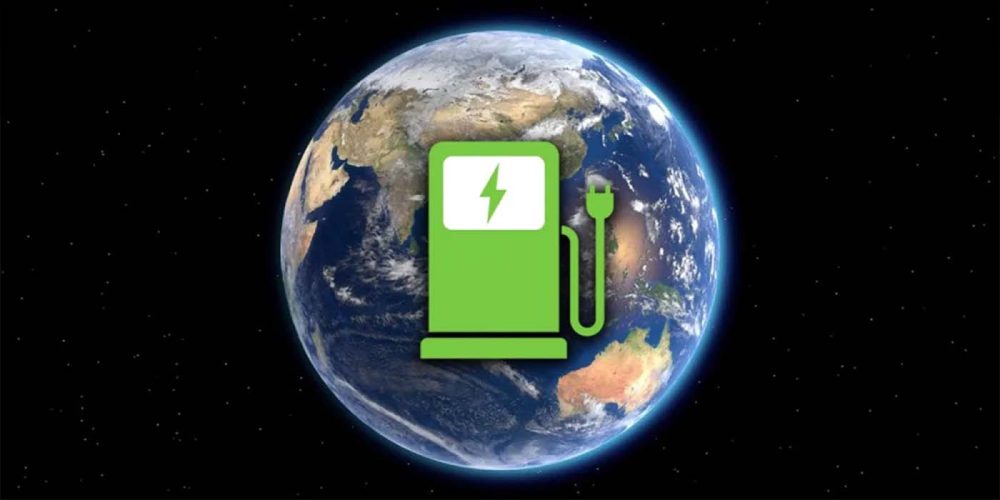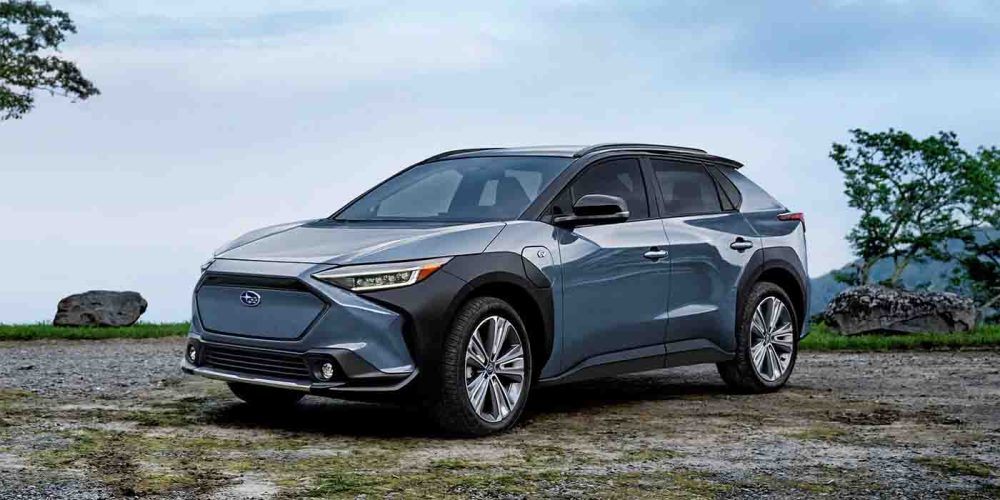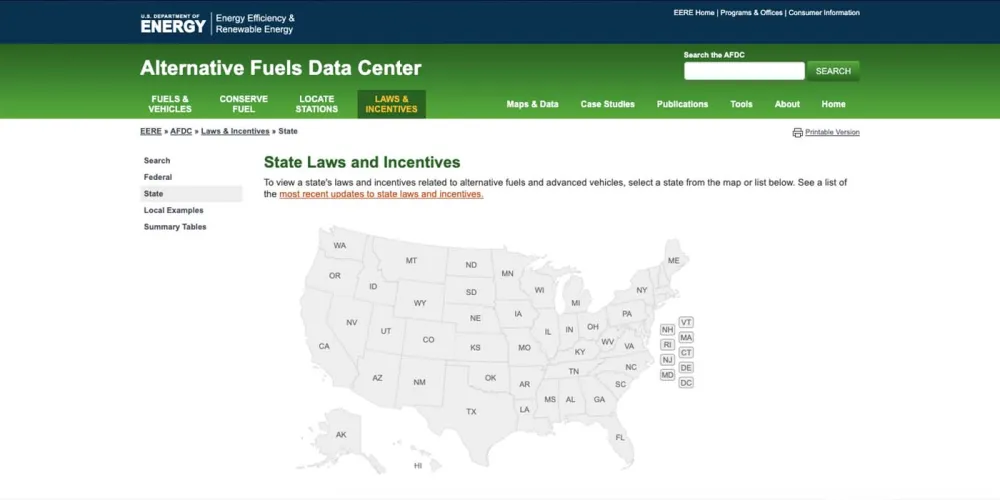
As sales of electric vehicles continue to surge, many new and prospective customers have questions about qualifying for federal tax credit on electric vehicles, especially now that a slew of new credits have been reinstated to US consumers.
Whether you qualify is not a simple yes or no question… well, actually it sort of is, but the amount you may qualify for varies by household due to a number of different factors. Furthermore, there are other potential savings available to you that you might not even know about yet.
Luckily, we have compiled everything you need to know about tax credits for your new or current electric vehicle into one place. The goal is to help ensure you are receiving the maximum value on your carbon-conscious investment because, let’s face it, you’ve gone green and you deserve it.
Table of contents
- How does a federal tax credit work for my EV?
- The Biden administration continues to expand EV adoption
- Revived EV tax credits have officially been signed by POTUS
- New Federal Tax Credits under the Inflation Reduction Act
- What electric vehicles qualify under the latest tax credit?
- What electric vehicles qualify under the previous tax credit?
- Other tax credits available for electric vehicle owners
- Tax incentives on electric vehicles are worth the research
How does a federal tax credit work for my EV?
The idea in theory is quite simple — “All electric and plug-in hybrid vehicles that were purchased new in or after 2010 may be eligible for a federal income tax credit of up to $7,500,” according to the US Department of Energy.
With that said, you cannot simply go out and buy an electric vehicle and expect Uncle Sam to cut $7,500 off your taxes in April. In reality, the amount you qualify for is based on both your income tax as well as the size of the electric battery in the vehicle you own.
Now, thanks to the freshly inked Inflation Reduction Act, there are a lot more parameters to be mindful of, like the requirement that the EV must be assembled in North America for instance. We have dug into those new terms more below.
To begin, here’s how the Federal EV tax credit currently works.

How much is the federal tax credit?
First and foremost, it’s important to understand three little words the government slips in front of the $7,500 credit – “may” and “up to.” As in, you may qualify for up to $7,500 in federal tax credit for your electric vehicle. At first glance, this credit may sound like a simple flat rate, but that is unfortunately not the case.
For example, if you purchased a Ford F-150 Lightning and owed say, $3,500 in income tax this year, then that is the federal tax credit you would receive. If you owed $10,000 in federal income tax, then you would qualify for the full $7,500 credit.
It’s important to note that any unused portion of the $7,500 is not available as a refund, nor as a credit for next year’s taxes. Bummer.
However, under new terms of the tax deal, you may be able to snag that credit up front at the point of sale of your EV. More on that below.

The Biden administration continues to expand EV adoption
President Biden first vowed to make the nation’s entire federal fleet all electric. The White House has introduced two bills to expand EV adoption, one of which was signed by the President and includes funding for heavily expanded EV charging infrastructure.
Previously, there were rumors that the federal tax credit would be increased to $10,000. In President Biden’s previous $174 billion investment plan for electrification, the tax credit was quickly mentioned as a reform. However, the summary remained vague about the reform – only confirming that it will not only take the form of tax rebates but also “point of sale rebates” and it will now be for “American-made EVs.”
The second and larger bill sat within Biden’s “Build Back Better Act” and subsequent increases to the federal tax credit, but it couldn’t get past the Senate in late 2021. At that point, the revamped tax credit we all have sought was in limbo, possibly DOA. Until this past summer…
Revived EV tax credits have officially been signed by POTUS
In late July 2022 the US Senate shared it was moving forward to vote on EV tax credit reform after Senator Joe Manchin took a break from huffing coal to finally agree to include investments to curb climate change.
One of the most prominent parts of the bill (to us) includes the long-awaited and fought over electric vehicle tax credit reform. In this iteration of the bill, access to the tax credit will be returned to those who have already exhausted the threshold, including Tesla and GM vehicles.
On August 7, 2022 it was approved by the Senate and a week later signed into law by President Biden.
The biggest issue we all are having with the Inflation Reduction act, is how cloudy and confusing its EV requirements are. Bear with us as we sort through it all, to once again provide you with the most up to date details of this ever evolving tale.
We have learned that the reform bill will also apply to EVs delivered after December 31, 2022. Here’s a breakdown of the terms of the new Inflation Reduction Act.
New Federal Tax Credits under the Inflation Reduction Act
- Federal tax credit for EVs will remain at $7,500
- Timeline to qualify is extended a decade from January 2023 to December 2032
- Tax credit cap for automakers after they hit 200,000 EVs sold is eliminated, making GM, Tesla and Toyota once again eligible
- The language in the bill indicates that the tax credit would be implemented at the point of sale instead of on taxes at the end of the fiscal year
- That means you can get your credit up front at the dealer
- In order to get the full credit, the EV must be assembled in North America and…
- The majority of battery components need to come from North America and…
- A certain percentage of “critical minerals” must come form North America or countries with free trade agreements with the US
- New federal tax credit of $4,000 for used EVs priced below $25k
- Subject to other requirements like lower annual income (see below)
- Revised credit applies to BEV cars with an MSRP below $55k
- Also includes zero-emission vans, SUVs, and trucks with MSRPs up to $80,000
- New credit also expands to commercial fleet customers
- Includes separate qualifications and limits
- The federal EV tax credit will be available to individuals reporting adjusted gross incomes of $150,000 or less, or $300,000 for joint filers
- The new credit will also continue to apply to Plug-in Hybrid EVs (PHEVs) as long as they meet the same requirements outlined above and are equipped with a battery over 7 kWh.
Here are more detailed terms of the tax credits under the inflation reduction act, detailed byl awyer, Chris Stidham:
Revamped Credit for new BEV/PHEVs
- Manufacturer caps eliminated. (Page 370, line 15)
- Credit applies for vehicles purchased beginning January 1, 2023. (Page 386, line 1)
- Transition provision for EVs with written sales orders dated in 2022 prior to the date of President signing the bill but delivered in 2023 allows purchaser to claim the “old” credit in 2023. (Page 386, line 20)
- Vehicle must be assembled in North America to qualify for new credit. (Page 366, line 15)
- North American assembly requirement applies to vehicles sold after the date of adoption of the bill. (Page 386, line 3)
- $7,500 credit is broke into two binary pieces meaning the vehicle either qualifies for each piece of the credit or it doesn’t. No longer based on size of battery. (Page 366, line 6)
- $3,750 of the new credit is based upon the vehicle having at least 40% of its battery critical minerals from the United States or countries with a free trade agreement with the United States. This is a list of countries with free trade agreements with the US. (Page 371)
- The other $3,750 of the new credit is based on at least 50% of the battery components of the vehicle coming from the United States or countries with a free trade agreement with the US. (Page 372, line 13)
- The 40% minerals requirement increases to 50% in 2024, 60% in 2025, 70% in 2026 and 80% in 2027. (page 371 line 23)
- The 50% battery components requirement increases to 60% in 2024, 70% in 2026, 80% in 2027, 90% in 2028 and 100% in 2029. (Page line 373)
- The government has until the end of the year to develop guidance on the battery requirements. (Page 374)
- Beginning in 2025, any vehicle with battery minerals or components from a foreign entity of concern are excluded from the tax credit. (Page 374, line 20).
- One credit per vehicle. (Page 375, line 12)
- Modified gross income limit of $150k for individuals, $225k for head of household, and $300k for joint returns. Definition of MAGI (page 375, line 22)
- MSRP of vehicle must be $80k or less for SUVs, Vans and Trucks. $55k for all other vehicles. (Page 377, line 4)
- Dealer can apply credit at time of sale. Dealer must disclose to buyer the MSRP of the vehicle, the applicable tax credit amount and the amount of any other available incentive applicable to the purchase. (Page 378, line 6)
- Credit terminates December 31, 2032.
Revamped Used Vehicle Credit
- Tax credit of 30% of value of used EV with $4,000 cap (Page 387, line 23).
- Used vehicle must be at least two model years old at time of sale. (Page 389, line 7).
- The original use of the vehicle must have occurred with an individual other than the one claiming the used tax credit. (Page 389, line 10).
- Used vehicle must be purchased from a dealer. (Page 390, line 3).
- Used vehicle price must be $25k or less. (Page 390, line 5).
- Used vehicle qualifies for tax credit only once in its lifetime. (Page 390, line 7)
- Purchaser must be an individual (no businesses) to qualify for used credit. (Page 390, line 14).
- Purchaser may only claim one used vehicle credit per three years. (Page 390, line 20).
- Modified gross income cap of $75k for individuals, $112,500 for head of household and $150k for joint returns. (Page 388).
- Credit may be applied at time of sale by dealer. (Page 391, line 15).
- Credit terminates on December 31, 2032. (Page 391, line 12).
Lock in current electric vehicle credits before the terms change
As you’ll see from the rather barren list below of EVs that currently qualify under the new terms of the Inflation Reduction Act, a majority of EVs currently available for credits to US consumers will soon no longer qualify.
That isn’t to say they won’t be back on in the yes column come January 1, 2023 since many of these automakers do have North American production facilities. Other EVs like Rivian models for example are American made, but some are priced above the $80k threshold for trucks.
Fisker has been long touting is flagship Ocean SUV as an EV priced below $30k for those who qualify for the entire $7,500 credit. However, under the new terms, the Austrian built SUV will qualify for zero federal credits. That being said, its current MSRP of $37,499 is still pretty enticing, but this is a major blow to its marketing strategy to the point that the American automaker is now considering adding US production for the Ocean.
The quick workaround that felt like a mad scramble was some verbiage allowing for “written binding contracts” under a “transition rule” in the Inflation Reduction Act. That rule allowed consumers to still qualify if they signed the binding contract before the date of bill being signed into law, even if the car is delivered after the bill is signed. This is covered on page 393-394 of the bill.
Since the bill has been signed into law, this quick workaround is no longer possible. We’ve put together a full breakdown of where those tax credits stand for EV automakers not currently assembling in the North America.

What electric vehicles qualify under the latest tax credit?
Alright, this is probably the main reason why you’re here. If you scrolled through the details above, you may want to consider going back and at least skimming, because there are some major changes to federal tax credits to electric vehicles under the Inflation Reduction Act.
Under the terms mentioned above, these are the EVs that will qualify for the full $7,500 credit beginning January 1, 2023.
Please note that these qualifying vehicles are relevant at the time this post has been published. We will update this page as the vehicles and their designated credits change.
All-electric vehicles
| Make and Model | Full Tax Credit |
| CADILLAC (GM) (does not qualify until 1/1/23) | |
| Lyriq (2023) | $,7500 |
| CHEVROLET (GM) (does not qualify until 1/1/23) | |
| Bolt EUV (2022) | $7,500 |
| Bolt EV (2022-2023) | $7,500 |
| FORD | |
| F-150 Lightning (2022) | $7,500 |
| Mustang Mach-E (2022) | $7,500 |
| E-Transit (2022) | $7,500 |
| GMC (GM) (does not qualify until 1/1/23) | |
| Hummer EV Pickup (2022) | $7,500 |
| Hummer EV SUV (2022) | $7,500 |
| MERCEDES-BENZ | |
| EQS SUV (2023) | $7,500 |
| NISSAN | |
| LEAF (2022-2023) | $7,500 |
| RIVIAN | |
| EDV 700 (2022) | $7,500 |
| R1T (2022) | $7,500 |
| R1S (2022) | $7,500 |
| TESLA (does not qualify until 1/1/23) | |
| Model 3 (2022) | $7,500 |
| Model Y (2022) | $7,500 |
| Model S (2022) | $7,500 |
| Model X (2022) | $7,500 |

Plug-in Hybrid Electric Vehicles
| Make and Model | Full Tax Credit |
| AUDI | |
| Q5 (2022) | $7,500 |
| BMW | |
| 330e (2022-2023) | $7,500 |
| X5 xDrive45e (2022) | $7,500 |
| CHRYSLER | |
| Pacifica Plug-in Hybrid (2022) | $7,500 |
| FORD | |
| Escape Plug-in Hybrid (2022) | $7,500 |
| JEEP | |
| Grand Cherokee PHEV (2022) | $7,500 |
| Wrangler Unlimited PHEV (2022) | $7,500 |
| LINCOLN | |
| Aviator PHEV (2022) | $7,500 |
| Corsair Plug-in Hybrid (2022) | $7,500 |
| VOLVO | |
| S60 (2022) | $7,500 |
Additionally, the Department of Energy’s Alternative Fuels Data Center has released the full list of vehicles with final assembly in North America, which may be updated more quickly going forward.
What electric vehicles qualify under the previous tax credit?
Although the credits above should be the focus going forward, we wanted to keep the previous credit details below. Less of a trip down memory lane, but more of a list of what EVs previously qualified, so you can gather how many will be lost under current terms.
As we previously mentioned however, some of these EVs could eventually once again qualify, as automakers pivot to bring their assembly to North America.
All-electric vehicles
| Make and Model | Full Tax Credit |
| AUDI | |
| e-tron Sportback (2020-2022) | $7,500 |
| e-tron SUV (2019, 2021-2022) | $7,500 |
| e-tron GT / RS e-tron GT (2022) | $7,500 |
| e-tron S (Standard and Sportback) | $7,500 |
| Q4 50 e-tron Quattro | $7,500 |
| BMW | |
| i3 Sedan (2014-2021) | $7,500 |
| i3s (2018-2021) | $7,500 |
| i4 eDrive40/M50 Gran Coupe (2022) | $7,500 |
| iX xDrive50/M60 (2022) | $7,500 |
| BYD | |
| e6 (2012-2017) | $7,500 |
| ELECTRIC LAST MILE SOLUTIONS (ELMS) | |
| ELMS Urban Delivery (2022) | $7,500 |
| FIAT | |
| 500e (2013-2019) | $7,500 |
| FORD | |
| Focus EV (2012-2018) | $7,500 |
| Mustang Mach-E (all 2021/2022 trims including GT) | $7,500 |
| E-Transit (2022) | $7,500 |
| F-150 Lightning (standard/extended range) (2022) | $7,500 |
| GENERAL MOTORS (GM) | |
| Not currently eligible for tax credits | ––––– |
| GENESIS | |
| GV60 (2023) | $7,500 |
| HYUNDAI | |
| Ioniq Electric (2017-2021) | $7,500 |
| Ioniq 5 (2022) | $7,500 |
| Kona Electric (2019-2022) | $7,500 |
| JAGUAR | |
| I-Pace (2019-2022) | $7,500 |
| I-Pace HSE (2022-2023) | $7,500 |
| KANDI | |
| EX3 (2019-2021) | $7,500 |
| K22 (2019-2020) | $7,500 |
| K23 (2020-2022) | $7,500 |
| K27 (2020-2022) | $7,500 |
| KIA | |
| Niro EV (2019-2022) | $7,500 |
| Soul Electric (2015-2020) | $7,500 |
| EV6 (58 kWh, 77.4 kWh) (2022) | $7,500 |
| LUCID MOTORS | |
| Lucid Air Dream Edition (2022) | $7,500 |
| Lucid Air Grand Touring (2022) | $7,500 |
| MAZDA | |
| MX-30 (2022) | $7,500 |
| MERCEDES-BENZ | |
| AMG EQS (2022) | $7,500 |
| EQS 450+ (2022) | $7,500 |
| EQS 580 4matic (2022) | $7,500 |
| B-Class EV (2014-2017) | $7,500 |
| MINI | |
| Cooper S E Hardtop 2 & 4 Door (2020-2023) | $7,500 |
| MITSUBISHI | |
| i-MiEV (2012, 2014, 2016, 2017) | $7,500 |
| NISSAN | |
| LEAF (2011-2022) | $7,500 |
| POLESTAR | |
| Polestar 2 (2021) | $7,500 |
| Polestar 2 Long Range – Single & Dual Motor (2022) | $7,500 |
| PORSCHE | |
| Taycan (2020-2022) (all trims) | $7,500 |
| RIVIAN | |
| R1T (2022) | $7,500 |
| R1S (2022) | $7,500 |
| EDV 700 (2022) | $7,500 |
| SMART USA | |
| EQ fortwo Coupe (2019) | $7,500 |
| EQ fortwo Cabrio (2019) | $7,500 |
| SUBARU | |
| Solterra (2023) | $7,500 |
| TESLA | |
| Not currently eligible for tax credits | ––––– |
| TOYOTA | |
| Toyotas purchased after 9/30/23 are no longer eligible for tax credits | ––––– |
| RAV4 EV (2012-2014) | $7,500 |
| VOLKSWAGEN | |
| e-Golf (2015-2019) | $7,500 |
| ID.4 EV (First/Pro/Pro S) (2021) | $7,500 |
| VOLVO | |
| C40 Recharge Pure Electric (2022) | $7,500 |
| XC40 Recharge Pure Electric (2021-2022) | $7,500 |

Plug-in hybrid electric vehicles (PHEVs)
The US Department of Energy offers the full detailed list on its website.
| Make and Model | Full Tax Credit |
| AUDI | |
| A3 e-tron / e-tron ultra (2016-2018) | $4,502 |
| A7 55 TFSI e Quattro (2021) | $6,712 |
| A7 TFSI e Quattro (2022) | $7,500 |
| A8L PHEV (2020) | $6,712 |
| A8L 60 TFSI e Quattro (2021) | $6,712 |
| Q5 PHEV (2020) | $6,712 |
| Q5 55 TFSI e Quattro (2021) | $6,712 |
| Q5 TFSI e Quattro (2022) | $7,500 |
| BENTLEY | |
| Bentayga Hybrid (2020-2021) | $7,500 |
| BMW | |
| i3 Sedan w/ Range Extender (2014-2021) | $7,500 |
| i3s w/ Range Extender (2018-2021) | $7,500 |
| BMW i8 (2014-2017) | $3,793 |
| i8 Coupe/Roadster (2018-2020) | $5,669 |
| X3 xDrive30e (2020-2021) | $5,836 |
| X5 xDrive40e (2016-2018) | $4,668 |
| X5 xDrive45e (2021-2022) | $7,500 |
| 330e (2016-2018) | $4,001 |
| 330e/330e xDrive (2021-2022) | $5,836 |
| 530e/530e xDrive (2018-2019) | $4,668 |
| 530e/530e xDrive (2020-2022) | $5,836 |
| 740e (2017) | $4,668 |
| 740e xDrive (2018-2019) | $4,668 |
| 745e xDrive (2020-2022) | $5,836 |
| CHRYSLER | |
| Pacifica Plug-In Hybrid (2017-2022) | $7,500 |
| FERRARI | |
| SF90 Stradale (2020-2021) | $3,501 |
| FISKER AUTOMOTIVE | |
| Karma Sedan (2012) | $7,500 |
| FORD | |
| C-Max Energi (2013-2017) | $4,007 |
| Fusion Energi (2013-2018) | $4,007 |
| Fusion Energi (2019-2020) | $4,609 |
| Escape Plug-in Hybrid (2020-2022) | $6,843 |
| GENERAL MOTORS (GM) | |
| Not currently eligible for tax credits | ––––– |
| HONDA | |
| Accord Plug-in Hybrid (2014) | $3,626 |
| Clarity Plug-in Hybrid (2018-2021) | $7,500 |
| HYUNDAI | |
| Ioniq Plug-in Hybrid (2018-2022) | $4,543 |
| Sonata Plug-in Hybrid (2016-2019) | $4,919 |
| Tucson Plug-in Hybrid (2022) | $6,587 |
| Santa Fe Plug-in Hybrid (2022) | $6,587 |
| JEEP | |
| Grand Cherokee PHEV (2022) | $7,500 |
| Wrangler Unlimited PHEV (2021-2022) | $7,500 |
| KARMA | |
| Revero (2018-2020) | $7,500 |
| KIA | |
| Niro Plug-in Hybrid (2018-2022) | $4,543 |
| Optima Plug-in Hybrid (2017-2020) | $4,919 |
| Sorento Plug-in Hybrid (2022) | $6,587 |
| LAND ROVER | |
| Range Rover/Sport PHEV (2019) | $7,087 |
| Range Rover/Sport PHEV (2020-2022) | $6,295 |
| Range Rover SE PHEV (2023) | $7,500 |
| Rover Range Rover Sport Autobiography PHEV (2023) | $7,500 |
| LEXUS | |
| Lexus’ purchased after 9/30/23 are no longer eligible for tax credits | ––––– |
| NX Plug-in Hybrid (2022) | $7,500 |
| LINCOLN | |
| Aviator Grand Touring (2020-2022) | $6,534 |
| Corsair Reserve Grand Touring PHEV (2021-2022) | $6,843 |
| Corsair Grand Touring PHEV (2022) | $6,843 |
| McLAREN | |
| Artura (2022) | $4,585 |
| MERCEDES-BENZ | |
| S550e Plug-in Hybrid (2015-2017) | $4,460 |
| GLE550e 4matic (2016-2018) | $4,460 |
| GLC350e 4matic (2018-2019) | $4,460 |
| GLC350e 4M EQ (2020) | $6,462 |
| S560e EQ PHEV (2020) | $6,462 |
| C350e (2016-2018) | $3,501 |
| MINI | |
| Cooper S E Countryman ALL4 (2018-2019) | $4,001 |
| Cooper S E Countryman ALL4 (2020-2022) | $5,002 |
| MITSUBISHI | |
| Mitsubishi Outlander Plug-in (2018-2020) | $5,836 |
| Mitsubishi Outlander Plug-in (2021-2022) | $6,587 |
| POLESTAR | |
| Polestar 1 (2020-2021) | $7,500 |
| PORSCHE | |
| Cayenne S E-Hybrid (2015-2018) | $5,336 |
| Cayenne E-Hybrid / Coupe (2019-2020) | $6,712 |
| Cayenne Turbo S E-Hybrid / Coupe (2021) | $7,500 |
| Cayenne E-Hybrid / Coupe (2021-2022) | $7,500 |
| Panamera S E-Hybrid (2014-2016) | $4,752 |
| Panamera 4 E-Hybrid (2018) | $6,670 |
| Panamera 4 E-Hybrid (2019-2020) | $6,712 |
| Panamera 4 E-Hybrid (2021-2022) | $7,500 |
| SUBARU | |
| Crosstrek Hybrid (2019-2022) | $4,502 |
| TESLA | |
| Not currently eligible for tax credits | ––––– |
| TOYOTA | |
| Toyotas purchased after 9/30/23 are no longer eligible for tax credits | ––––– |
| Prius Plug-in Hybrid (2012-2015) | $2,500 |
| Prius Prime Plug-in Hybrid (2017-2022) | $4,502 |
| RAV4 Prime Plug-in Hybrid (2021-2022) | $7,500 |
| VOLVO | |
| S60 (2019) | $5,002 |
| S60 (2020-2022) | $5,419 |
| S60 Extended Range (2022) | $7,500 |
| S90 (2018-2019) | $5,002 |
| S90 (2020-2022) | $5,419 |
| S90 Extended Range (2022) | $7,500 |
| V60 (2020-2022) | $5,419 |
| V60 Extended Range (2022) | $7,500 |
| XC60 (2018-2019) | $5,002 |
| XC60 (2020-2022) | $5,419 |
| XC60 Extended Range (2022) | $7,500 |
| XC90 (2016-2017) | $4,585 |
| XC90 / XC90 Excellence (2018-2019) | $5,002 |
| XC90 (2020-2022) | $5,419 |
| XC90 Extended Range (2022) | $7,500 |
Other tax credits available for electric vehicle owners
So now you should know if your vehicle does in fact qualify for a federal tax credit, and how much you might be able to save.
State tax incentives
In additional to any federal credit you may or may not qualify for, there are a number of clean transportation laws, regulations, and funding opportunities available at the state level.
For example, in the state of California, drivers can qualify for a $2,000-$4,500 rebate or a grant up to $5,000 under the Clean Vehicle Assistance Program on top of any federal credit received (all rebate and grant amounts are based on income). Furthermore, states like California offer priority driving lanes and parking spots for EV drivers who qualify.
In New York, residents can receive either a $500 or $2,000 rebate depending on the base price of the EV purchased. Again, these incentives vary by state, and much like the federal tax credit, are contingent on multiple factors.
To check what incentives you may qualify for, the Alternative Fuels Data Center is a great resource from the US Department of Energy. This page allows you to tap or click your respective state and research what options might be available to you and your electric vehicle.

Tax incentives on electric vehicles are worth the research
Hopefully this post has helped to incentivize you to use the resources above to your advantage.
Whether it’s calculating potential savings or rebates before making a new EV purchase or determining what tax credits might already be available to you for your current electric vehicle, there is much to discover.
Ditching fossil fuels for greener roadways should already feel rewarding, but right now the government is willing to reward you further for your environmental efforts.
Use it to your full capability while you can, because as more and more people start going electric, the less the government will need to reward drivers.
Add Electrek to your Google News feed.
google-news
Subscribe to Electrek on YouTube for exclusive videos and subscribe to the podcast.
Author: Scooter Doll
Source: Electrek



